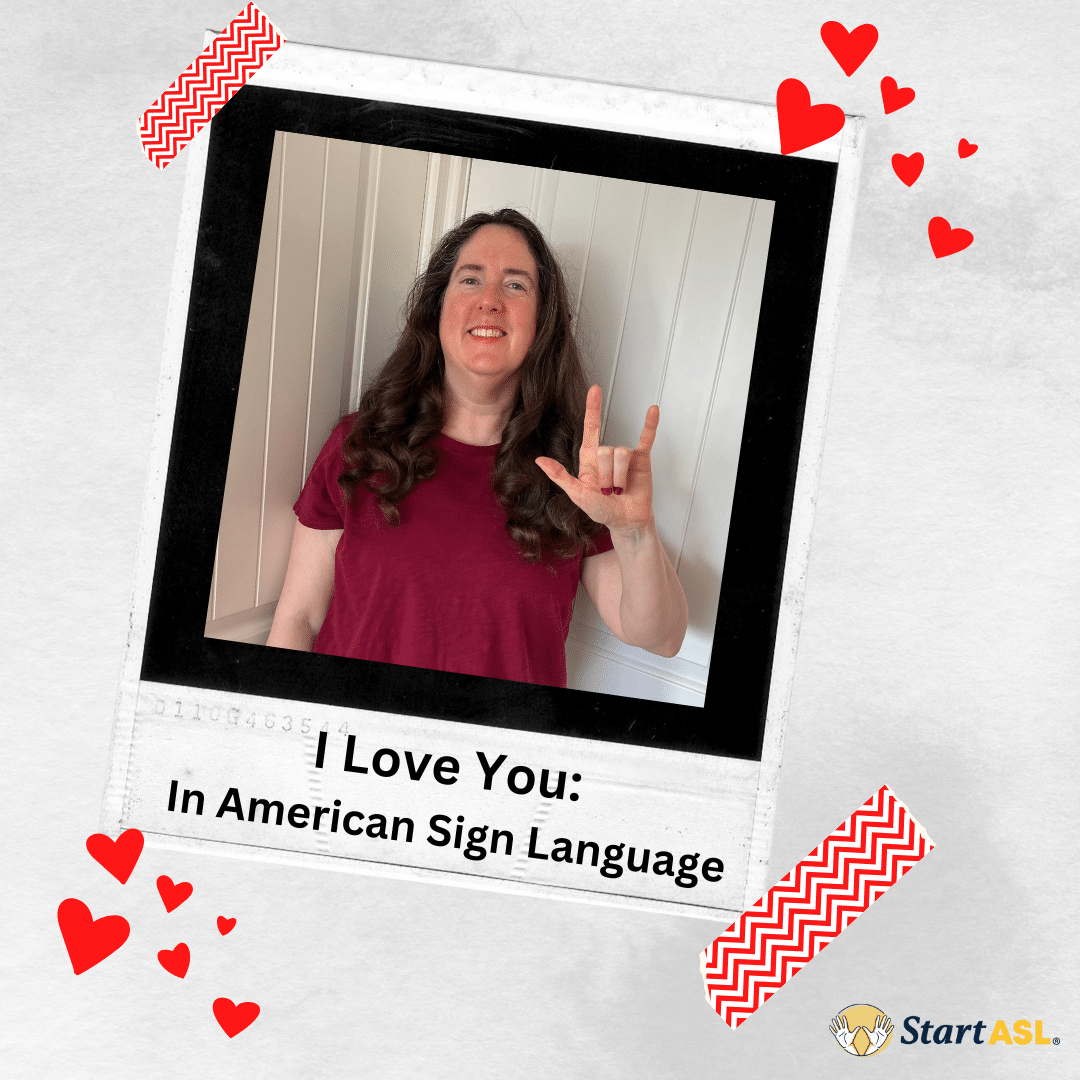
Deaf Friendly During the Holidays
- by Start ASL
- No Comments
By Megan Clancy
When Deaf and hard of hearing people attend family functions or interact with friends and family during the holidays, it can become frustrating since group conversations in spoken language can be hard to follow. Extended family members often do not know ASL so they can’t really freely communicate with Deaf and hard of hearing family members. That is why
Deaf people may not say anything except Thanksgiving or Christmas, some of their favorite holidays when they can interact with their Deaf friends who can converse via ASL.
Conversing with deaf people during the holidays can be a rewarding experience, and it’s great to be inclusive! Here are some tips to help you communicate effectively:
Learn Basic Sign Language: Familiarizing yourself with some basic signs can go a long way. Even simple greetings or phrases can show your willingness to communicate.
Here are some basic sign language greetings and phrases to get you started:
- Hello: Raise your hand to your forehead and move it away from your face, like a salute.
- Goodbye: Wave your hand, just like in spoken language.
- Thank you: Place your fingers on your chin and move your hand slightly forward, away from your face.
- Please: Place your flat hand on your chest and move it in a circular motion.
- Yes: Nod your fist up and down, like a nodding head.
- No: Bring your fingers together and make a fist, then open and close it.
- Help: Place one hand under the other in a “give me a hand” gesture.
- Sorry: Make a fist and rub it in a circular motion on your chest.
These signs can help you communicate effectively and show respect for the Deaf community!
Learn with StartASL! Start with our Top 150 Basic ASL sign Language Words. Then check out our free ASL Lessons! When you are ready to dive into the language, check out our full course for options for learning with us!
Start ASL’s Top 150 Basic ASL Sign Language Words
https://www.startasl.com/basic-words-in-sign-language/
ASL 1 For Free
https://www.startasl.com/learn-sign-language-asl/
Start ASL All Course Options
https://www.startasl.com/learn-american-sign-language/
Use Clear Body Language: Non-verbal cues are important. Maintain eye contact, and use facial expressions, and gestures to convey your message. Clear body language enhances communication significantly. Here are some tips to improve your non-verbal cues:
- Eye Contact: Maintain eye contact to show attentiveness and engagement. It builds trust and connection.
- Facial Expressions: Use expressions that match your message. A smile can convey friendliness, while a frown can express concern.
- Gestures: Use hand movements to emphasize points. Keep gestures natural and avoid overdoing them, as this can be distracting.
- Posture: Stand or sit up straight to convey confidence. Open posture (uncrossed arms and legs) makes you appear approachable.
- Nodding: Nod occasionally to show understanding and encourage the other person to continue.
- Space: Be mindful of personal space. Respecting it helps others feel comfortable.
- Mirroring: Subtly mimic the other person’s body language to create rapport, but be careful not to overdo it.
By combining these elements with your spoken or signed language, you can communicate more effectively and create a positive interaction!
Speak Clearly: If the person reads lips, speak clearly and at a normal pace. Avoid covering your mouth or turning away while speaking. Here are some tips for speaking clearly, especially for those who read lips:
- Face the Person: Always face the person you’re communicating with. This helps them see your lips and facial expressions.
- Speak Naturally: Use a normal tone and pace. Speaking too slowly or loudly can distort your lip movements.
- Avoid Obstructions: Keep your hands away from your mouth, and don’t chew gum or eat while speaking.
- Use Clear Articulation: Pronounce your words clearly. Avoid mumbling or slurring your speech.
- Facial Expressions: Use appropriate facial expressions to add context to your message. This helps convey emotions and intent.
- Pause for Understanding: Give the person time to process what you’re saying. Pausing can also allow them to catch up if they’re reading lips.
- Check for Understanding: Ask if they understand or need clarification. This shows you care about effective communication.
By following these tips, you can make your conversations more accessible and engaging for everyone involved!
Use Written Communication: If sign language isn’t an option, writing notes or using a messaging app can facilitate conversation. Written communication is a great alternative when sign language isn’t an option. Here are some tips for effective written communication:
- Be Clear and Concise: Use simple language and get straight to the point. Avoid long sentences that might confuse the reader.
- Use Bullet Points: If you have multiple points to make, bullet points can help organize information clearly.
- Highlight Key Information: Use bold or underline to emphasize important details, making them easier to spot.
- Stay Organized: Structure your notes or messages logically. This helps the reader follow along without getting lost.
- Use Visuals: If appropriate, include diagrams or images to clarify your message. Visual aids can enhance understanding.
- Check Spelling and Grammar: Take a moment to proofread your message. Clear writing helps prevent misunderstandings.
- Be Patient: Allow time for the other person to read and respond. They might need a
moment to digest the information.
Using written communication can be very effective and inclusive. You can also texting that you can use as well.
Include Everyone: If you’re in a group, make sure to address the deaf person directly rather than speaking to someone else about them. This helps them feel included. This is important since I recall my Deaf friend who had a wonderful hearing family with many nephews and nieces, but none of them knew any ASL. Her goal for her own family is to make sure no one is left out during conversations at the dinner table. Including everyone in a group conversation is essential for fostering an inclusive environment. Here are some tips to ensure everyone feels involved:
- Address the Deaf Person Directly: Speak to them rather than to someone else about them. This shows respect and acknowledges their presence.
- Maintain Eye Contact: When speaking, look at the Deaf person. This helps them feel engaged and valued in the conversation.
- Use Their Preferred Communication Method: If they use sign language, try to communicate using signs. If they prefer written communication, offer to write notes or use a messaging app.
- Be Mindful of Group Dynamics: If someone else is speaking, make sure to include pauses so the Deaf person can follow along, whether through signing or lip-reading.
- Encourage Group Participation: Invite everyone to share their thoughts, ensuring the Deaf person has the same opportunity to contribute.
- Use Visual Aids: If discussing complex topics, consider using whiteboards, slides, or other visual aids to support the conversation.
- Check for Understanding: Regularly ask if everyone is following along or if anyone has questions, making it clear that everyone’s input is valued.
By being mindful of these practices, you can create a welcoming atmosphere for everyone in the group!
Be Patient: Communication may take a bit longer, so be patient and give the other person time to respond. This is important to remember since I do remember my Deaf friends and I have experienced hearing this phrase: It’s not important or never mind or I’ll tell you later when we try to keep up what everyone is saying at parties. Patience is key in effective communication, especially with Deaf or hard-of-hearing individuals. Here are some ways to practice patience:
- Allow Extra Time: Recognize that processing information may take longer, so give the other person time to formulate their response without rushing them.
- Stay Engaged: Maintain eye contact and show that you’re actively listening. This encourages them to take their time without feeling pressured.
- Avoid Interrupting: Let them finish their thoughts before you respond. Interrupting can be frustrating and disrupt their train of thought. As a reminder, the person speaking can hold a ball and then pass it on when he or she finishes talking and pass the ball on to the next person who wants to speak.
- Be Understanding: If there are misunderstandings or if they need to clarify something, be open to repeating or rephrasing your message without frustration.
- Use Visual Supports: If they seem to be struggling to understand, offer to write things down or use visuals, but do so patiently.
- Encourage Questions: Make it clear that it’s okay to ask for clarification or to take their time to express their thoughts.
- Practice Active Listening: Show that you value their input. Nod or use affirming gestures to demonstrate that you are listening and engaged.
Being patient helps create a supportive environment where everyone feels comfortable communicating!
Respect Preferences: Some deaf people prefer sign language, while others might rely on lip-reading or written communication. Ask about their preferred method. Respecting individual preferences is crucial for effective communication. Here are some tips on how to approach this:
- Ask Politely: When you first meet a Deaf person, you can say something like, “What’s your preferred way to communicate?” This shows that you value their choice.
- Be Flexible: Be open to switching communication methods based on their preference. If they prefer sign language, be ready to engage with that; if they prefer writing or lip-reading, adapt accordingly.
- Avoid Assumptions: Don’t assume that everyone uses the same method. Each person’s experience and preference can vary greatly.
- Use Clear Language: If you’re communicating verbally, speak clearly and avoid jargon. If they’re using sign language, be attentive to their signs.
- Check for Comfort: After you start communicating, ask if they’re comfortable with the method being used. They may appreciate the opportunity to adjust if needed.
- Be Respectful of Communication Styles: Some people may switch between methods depending on the situation. Respect their choice without making them feel self-conscious.
- Educate Yourself: Familiarize yourself with different communication methods used within the Deaf community. This knowledge can help you navigate conversations more effectively.
By showing respect for each person’s preferred communication method, you create a more inclusive and comfortable environment.
Create an Inclusive Environment: If you’re hosting, ensure there’s good lighting for lip-reading and minimize background noise to aid communication. Creating an inclusive environment is essential for effective communication. Here are some practical tips to ensure everyone feels comfortable and included:
- Good Lighting: Make sure the area is well-lit, as this helps with lip-reading and seeing facial expressions clearly. Avoid backlighting that can create shadows on your face.
- Minimize Background Noise: Choose a quiet space for conversations. Turn off or lower the volume on TVs, radios, or other noisy distractions to help everyone hear better.
- Arrange Seating Thoughtfully: Set up seating in a circle or semi-circle so that everyone can see each other easily. This promotes engagement and makes communication more fluid.
- Use Visual Aids: If presenting information, consider using slides or handouts. Visual aids can help clarify your message and provide context.
- Limit Distractions: Keep the area free from clutter or unnecessary distractions that could take attention away from the conversation.
- Encourage Turn-Taking: In group discussions, promote a respectful turn-taking culture. This allows everyone to contribute without feeling overwhelmed.
- Be Mindful of Technology: If using digital devices, ensure that any screens are visible to everyone and that the text is large enough to read easily.
- Provide Breaks: If conversations are long, consider scheduling breaks to give everyone a chance to recharge and refocus.
By implementing these strategies, you can foster a welcoming atmosphere where everyone feels included and can communicate effectively.
Encourage Participation: Invite them into conversations and activities, making sure they feel part of the group. Encouraging participation is key to creating an inclusive atmosphere. Here are some ways to invite Deaf or hard-of-hearing individuals into conversations and activities:
- Direct Invitations: Make a point to invite them to join conversations and activities. For example, you might say, “We’d love to hear your thoughts on this!”
- Use Their Preferred Communication Method: If they prefer sign language or written communication, engage with them in that manner to ensure they can participate fully.
- Include Everyone in Discussions: When discussing topics, explicitly address the Deaf person and encourage them to share their insights or opinions.
- Be Mindful of Group Dynamics: If a group is having a lively discussion, be sure to include quieter members by asking open-ended questions that invite everyone to contribute.
- Create Group Activities: Organize inclusive activities that require collaboration, allowing everyone to work together and engage with one another.
- Acknowledge Contributions: Recognize and validate their input when they share ideas or opinions, reinforcing that their participation is valued.
- Check-In: Regularly ask if they have any questions or thoughts on the topic at hand, making sure they feel comfortable to contribute.
- Foster a Supportive Atmosphere: Encourage a culture of respect and openness where everyone feels safe to share without fear of judgment.
By actively encouraging participation, you help create a sense of belonging that enriches the experience for everyone involved!
Celebrate Diversity: Use this opportunity to learn about deaf culture and experiences. It can enrich your understanding and create a more inclusive holiday atmosphere.
By being mindful and open, you can make your holiday gatherings enjoyable for everyone! Celebrating diversity, especially by learning about Deaf culture, can greatly enrich your interactions and create a more inclusive environment. Here are some ways to embrace this opportunity:
- Educate Yourself: Read books, watch documentaries, or explore online resources about Deaf culture, history, and experiences. Understanding the nuances can enhance your appreciation. Also, you can educate kids not to ask the Deaf/ hard of hearing person why he or she sounds different. You can explain to the kids that Deaf and hard of hearing people can sound different from hearing people because of their unique backgrounds.
- Attend Events: Look for local Deaf community events, workshops, or performances. Participating in these can provide firsthand insights and foster connections.
- Invite Guest Speakers: If you’re hosting a gathering, consider inviting someone from the Deaf community to share their experiences or insights. This can open up meaningful discussions.
- Learn Basic Sign Language: Familiarizing yourself with basic signs not only facilitates communication but also shows respect for Deaf culture.
- Encourage Storytelling: Create spaces for individuals to share their experiences or stories related to Deaf culture. This can be a powerful way to learn and connect.
- Celebrate Deaf Art and Music: Explore and share works by Deaf artists and musicians. Many express unique perspectives and experiences that can be enlightening.
- Highlight Diverse Experiences: Remember that the Deaf community is diverse, encompassing various backgrounds, experiences, and preferences. Celebrate this diversity within the community.
- Incorporate Inclusive Practices: In your gatherings or activities, implement practices that recognize and celebrate diversity, such as using visual aids or ensuring good lighting.
By actively celebrating and learning about diversity, you can create a richer, more inclusive atmosphere that honors all participants.
Also refer to our other article for more information:
https://www.startasl.com/how-to-converse-with-deaf-people-during-the-holidays/
Start ASL’s Top 150 Basic ASL Sign Language Words
https://www.startasl.com/basic-words-in-sign-language/
ASL 1 For Free
https://www.startasl.com/learn-sign-language-asl/
Start ASL All Course Options
https://www.startasl.com/learn-american-sign-language/










